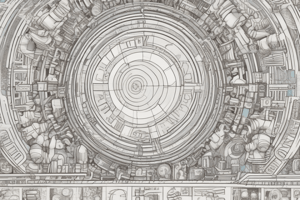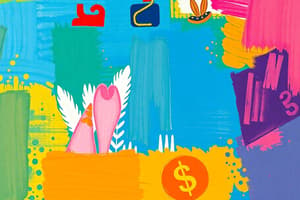Podcast
Questions and Answers
What is a characteristic of products in the decline phase of the product lifecycle?
What is a characteristic of products in the decline phase of the product lifecycle?
- The product may be withdrawn from sale due to declining profits. (correct)
- Sales are high with increasing profits.
- Market share is consistently expanding.
- Products are typically undergoing continuous modification.
Which of the following is not an effective strategy for extending the lifecycle of a product?
Which of the following is not an effective strategy for extending the lifecycle of a product?
- Changing the target market to reach new consumers.
- Adding more features to the existing product.
- Updating packaging to attract attention.
- Increasing production costs without product changes. (correct)
Which option best describes the concept of changing the promotion in the context of product lifecycle management?
Which option best describes the concept of changing the promotion in the context of product lifecycle management?
- Increasing prices to create a perception of higher value.
- Reducing the number of advertising channels used.
- Altering the physical product to enhance its appeal.
- Rebranding or relaunching products to renew consumer interest. (correct)
When adjusting the target market to extend a product's lifecycle, what is typically the driving factor?
When adjusting the target market to extend a product's lifecycle, what is typically the driving factor?
What is a common feature of products in the maturity phase of their lifecycle?
What is a common feature of products in the maturity phase of their lifecycle?
What is a primary purpose of product modification in the product lifecycle?
What is a primary purpose of product modification in the product lifecycle?
Which of the following is NOT an example of product lifecycle extension?
Which of the following is NOT an example of product lifecycle extension?
What has been a significant outcome of Burberry's rebranding efforts?
What has been a significant outcome of Burberry's rebranding efforts?
What is a potential benefit of using the product lifecycle model for Burkenstock?
What is a potential benefit of using the product lifecycle model for Burkenstock?
Which factor is essential when modifying a product to target a new market?
Which factor is essential when modifying a product to target a new market?
Flashcards are hidden until you start studying
Study Notes
Maturity Phase
- Sales are high but profits start to fall due to intense competition
- Increased competition means products are discounted to maintain sales volume
- This leads to lower prices or sales
Decline Phase
- Sales and profits continue to decline
- Products may be withdrawn from sale
- Products in this stage may be heavily discounted
- Disposable items are replacing repairable goods
Product Lifecycle Extension Strategies
- Updating packaging: Updating the packaging can give the product a new look and feel to appeal to new customers.
- Adding More or Different Features: Improve the product with new features to entice new customers.
- Changing Target Market: Target a new audience by modifying the product or marketing message.
- Advertising: Renewed advertising campaigns build awareness and encourage sales.
- Price Reduction: Lowering the price can increase sales volume and clear out existing stock.
iPhone Example
- The iPhone has been constantly modified since its launch in 2007.
- New versions with features and benefits are released to encourage consumers to upgrade.
Product Modification
- Car styling: Cars retain the same engine but change their styling to appear more modern.
- This approach can either sell to new markets or remind old markets that it's time to upgrade.
Product Lifecycle Extension - Rebranding
- Rebranding can involve a simple logo or packaging change or, as in the case of JIF to CIF, a complete name change.
Product Lifecycle Extension - Relaunch
- Burberry: Rebranded itself and now uses brand ambassadors to promote its image.
Product Lifecycle Extension - Promotion
- The North Face has expanded its target audience to include teenagers.
Benefits of Product Lifecycle
- Helps develop promotional strategies for new products in the growth stage.
- Aids in making decisions about established products.
Product Lifecycle Diagram
- Products go through a lifecycle from research and development through to decline.
- Some products take longer to go through this lifecycle than others.
- The marketing mix for a product will change depending on its stage in the lifecycle.
Product Development Stage
- Products are designed and market research is analyzed to meet customer needs.
- Cash flow is tight with high development costs.
- The product is not yet generating revenue or profit, so all capital is an investment.
Introduction Stage
- High research and development costs.
- Product may have been test marketed before launch.
- Sales are low due to low customer awareness.
- Advertising focuses on informing customers about the product’s availability.
Growth Stage
- Sales and profits grow rapidly.
- Customers are aware of the product and demand is high.
- Advertising aims to capitalize on high demand.
Maturity Stage
- Sales are at a high but steady level.
- Customers are loyal to the product.
- Competition is intense, possibly forcing price reductions or sales.
Decline Stage
- Sales and profits fall.
- Product may be withdrawn from sale.
- Products may be heavily discounted.
- The product may become obsolete.
Studying That Suits You
Use AI to generate personalized quizzes and flashcards to suit your learning preferences.



